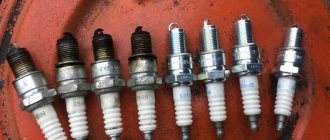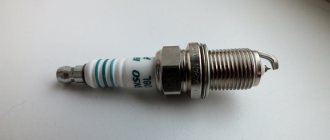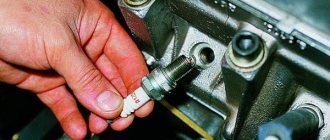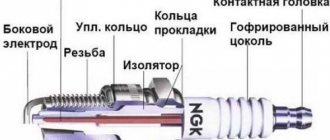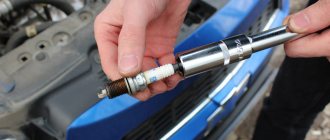After numerous experiments and failures, all designers of automobile gasoline engines settled on the spark method of igniting the working mixture. For more than a hundred years, this principle has not changed; only its components are improved. One of them is a spark plug, which directly forms a plasma discharge in a mixture of gasoline and air, which is under high pressure at the end of the compression stroke. Working conditions are difficult, demands on devices are constantly increasing.
Purpose of spark plugs
The spark plug is designed to convert the energy of a high-voltage electrical pulse generated by the ignition coil into hot plasma - a clot of ionized gas between the electrodes.
The temperature here is measured in thousands of degrees, which ensures uninterrupted ignition of the compressed combustible mixture.
This is interesting: Why one or two cylinders may not work
In addition, the part must comply with its other functions:
- reliably seal the threaded spark plug hole in the material of the block head that forms the combustion chamber;
- withstand extreme temperatures and pressures that arise during the combustion of the mixture during the working stroke of the piston;
- have a strictly defined temperature during operation, going beyond the permitted range is fraught with both the formation of soot and soot at its low value, as well as glow ignition or destruction due to overheating;
- have the property of self-cleaning during operation in the environment of burning hydrocarbons of gasoline and motor oil;
- maintain the established operating time, being subjected to electrical erosion and shock loads;
- Prevent leakage of high voltage currents to the engine ground.
At the same time, the spark plug, being a consumable, that is, a part with scheduled replacement, should not be expensive or create problems during engine maintenance operations.
Operating principle and characteristics
Formation of a spark on the electrodes
The main task of a spark plug is to form a spark and maintain it for the required amount of time. To do this, low voltage from the car battery is converted into high voltage (up to 40,000 V) in the ignition coil, and then supplied to the spark plug electrodes, between which there is a gap. “Plus” from the coil comes to the central electrode, “minus” - to the side of the engine.
At the moment of voltage formation on the electrodes (“plus” from the coil on the central one and “minus” on the side of the engine), sufficient to overcome (breakdown) the resistance of the medium in the gap, a spark appears between them.
Spark gap value
The spark gap is the main parameter of spark plugs. It determines the minimum distance between the electrodes to ensure the formation of a spark of sufficient size and the possibility of breakdown of the corresponding layer of the medium (fuel-air mixture under pressure).
Spark gap
The gap size must be within the limits specified by the manufacturer. If the gap is too large, the spark discharge energy may not be enough to maintain the required burning time of the candle and the mixture may not ignite. On the other hand, too small a gap will lead to burnout of the electrodes and increased wear of the spark plugs.
The size of the spark gap differs depending on the operating mode of the engine and its type and manufacturer. The lower threshold of the spark gap can be about 0.4 mm, and the upper threshold can reach 2 mm.
To check the size of the spark gap, a special tool is used - a probe, which can be round or flat. The second type is easier to use, but gives an error because it does not take into account the wear of the electrode surface. The gap is adjusted to the required size manually by bending the side electrode.
What is heat number
Location of the spark plug in the engine
An equally important parameter is the heat rating. It determines the thermal properties of the structure and demonstrates at what pressure in the combustion chamber uncontrolled self-ignition of the air-fuel mixture (glow ignition) can occur. In simple words, the higher the heat value, the less the spark plug will heat up during engine operation.
Designs with different heat ratings are used according to the type of motor, mode and conditions of its operation. So, in the summer and under increased loads, it is optimal to use designs with a high heat rating, and in winter or during quiet driving in the city - with a lower one.
Spark plugs with a low heat rating are installed in low-pressure engines running on fuel with a low octane rating. Designs with a high heat rating, on the contrary, are used in engines with high compression and high temperature load of the combustion chamber.
Location
The spark plugs are screwed along the threads of their body into the block head. The exact location in the combustion chamber is determined by considerations of optimal ignition, but in civilian vehicles, layout considerations are primarily taken into account.
Therefore, the established scheme is that on four-valve cylinders the spark plugs are placed vertically in the camber of the intake and exhaust valves in the center of the combustion chamber. With a single-row valve arrangement, the housing is screwed in from the side at an angle, directly adjacent to the incoming fuel from the intake valve.
Installing new spark plugs
Step 1. Proper replacement of spark plugs. There are literally hundreds of different spark plug combinations and sizes, ranging in price from 200 to 800 rubles, made from platinum, yttrium, iridium, etc. The cost of candles made of precious metals is much higher than that of conventional materials, because such coatings are able to resist wear much better. If you are unsure, contact your auto parts dealer for advice.
- A good rule for car owners: buy spark plugs with the same dimensions and thread pitch as the old spark plugs currently have. Never choose new parts with a smaller size. The manufacturer chose these dimensions for a reason, so you should adhere to the same standards. To make sure you make the right choice, consult with specialists. It’s better to spend a few extra minutes on this right away than to deal with new problems that have arisen later;
- You will be presented with two options for spark plugs: with a fixed gap or with the ability to adjust it. If you want to regularly check your spark plugs and make adjustments, then the second option is for you. If you do this, you will get adjustable contacts. First of all, you need to make sure that the gap is normal for your vehicle. If you check it yourself, you will know for sure. Take them out of the packaging and do a quick test to take measurements.
Finally getting around to installing the new spark plugs.
Step 2: Insert the new spark plug into the hole. This must be done for each element separately. You must first tighten it by hand, then tighten it with a key. Do not over-tighten, otherwise you risk stripping the threads. Tighten with moderate force.
Don't forget the spark plug lubricant
Step 3: Lubricate them before installation. Try applying a little thread lubricant if you are installing them in an aluminum engine. Such a lubricant can prevent reactions between dissimilar metals.
Connect the wires, paying attention to the marks
Step 4. After this, you need to connect the wires. Taking into account the marks you made earlier, connect the wires correctly. In this case, the connectors must fit tightly. To check the installation of the cap, you need to slightly pull it towards you. If at the same time it does not jump off, then everything is done correctly.
Device
The candle consists of several functional parts:
- housings with threads, faces for a spark plug wrench and a sealing metal gasket or cone;
- an insulator covering the central electrode in the lower part, and the contact rod in the upper part;
- pairs of electrodes, the central one in the insulator, the side curved one welded to the lower threaded part of the housing;
- interference suppression resistance in the upper part of the insulator;
- linings made of noble metals on electrodes in the spark gap zone to improve properties and extend service life.
Breakdown occurs in the spark gap zone. To normalize it, the gap size is normalized; it can change when the electrodes burn. Sometimes it is permissible to correct the gap by bending the side electrode.
Glow plugs: reasons and replacement instructions
As with spark plugs, you should allow the engine to cool before replacing. Then you should disconnect the battery terminals and remove the keys from the ignition. To replace, you will need a similar set of tools, including a set of keys and hexagons, a torque wrench and a spark plug socket for 12.
Symptoms of a problem
The following signs indicate a malfunction of the glow element in a diesel engine :
- Power loss on a cold engine.
- Exhaust gases are white.
- Long starting engine.
Unlike spark-forming elements, faulty glow plugs will at most lead to unstable engine operation. In the worst case, the engine simply won’t start.
Causes
Unlike spark plugs, glow elements are much less capricious. Usually problems occur if the spark plugs are suitable for a given type of engine, or were installed incorrectly. In addition, a malfunction can occur as a result of electrochemical corrosion or simple wear.
Replacing glow plugs
Replacement of incandescent elements takes place according to the following algorithm:
- We carry out preliminary preparations and dismantle parts that block access to the incandescent elements.
- Unscrew the nuts securing the ends of the high-voltage wires.
- We remove the wires.
- Vacuum, blow or wipe down the area around the glow plugs.
- Using a torque wrench, unscrew the old glow plugs. Before unscrewing them, it is advisable to treat their joints with WD-40 or its equivalent and leave for 15-20 minutes.
- We clean the contacts on high-voltage wires.
- We clean the wells using a special reamer, after applying a cleaning agent to it.
- We screw in new glow plugs, having previously lubricated the threads with graphite lubricant.
- We put on the high-voltage wires and carry out the remaining assembly in the reverse order.
This completes the replacement procedure.
Types and markings
Candles for widespread use can be classified according to several criteria:
- heat number - the ability to maintain the operating temperature of the insulator within specified limits; spark plugs are usually divided into hot and cold, depending on its value;
- the size of the working gap, sometimes one model has different gaps between the electrodes, depending on the orientation to a particular engine;
- geometric characteristics - length of the threaded part of the body, type of thread, wrench size, electrode protrusion;
- quality and service life are determined mainly by the metals used in the working gap, these can be copper, nickel, platinum, iridium;
- resistance of the noise suppression resistor;
- type of seal, gasket or cone.
Usually, the designation of a candle encodes its main parameters. But there is no single system; each manufacturer has its own symbols.
Even the heat value can increase or decrease with increasing or decreasing digital index. Therefore, it makes no sense to take this data into account.
When choosing, you should focus solely on the factory catalog number of the engine manufacturer (OEM). Sometimes the recommended designation of the manufacturer of ignition devices is also indicated there. Or a search is carried out using crossnumbers - OEM analogues in company catalogs.
For these reasons, part manufacturers are moving away from performance coding. It’s easier to indicate the crossnumber and a link to the OEM of different automobile companies.
Drilling and unscrewing
If the first two methods do not help, you will need to remove the cylinder head cover and drill a hole in the spark plug holder. A special sleeve of the appropriate diameter is screwed into it, having either a hexagonal notch or a thread on the inside. This operation cannot be carried out on the engine, since there is a high risk of chips and metal dust getting into the working area of the cylinder.
It is better to take the cylinder head cover to a turning workshop, where the hole and installation of the “screw plug” will be done as carefully and accurately as possible, without damaging the thread. In any case, disassembling the cylinder head can serve as an excellent reason for routine repairs of the gas distribution mechanism, piston system and replacement of gaskets.
How to check spark plugs for functionality
Expensive candle models are usually subject to verification. Cheap devices are replaced as a set with new ones at the slightest doubt or if there is information about mileage over 5-10 thousand kilometers. The risk is too great, but the price is reasonable.
First of all, the condition of the insulator is assessed visually. It should be white with a slight brown tint. At a minimum, a dirty spark plug will have to be cleaned.
The condition of the electrodes and the gap size are checked (with a probe). When the metal wears out, the kit is replaced. The insulator must not have cracks or chips.
The only accurate control method is on a candle stand. In its transparent chamber, a pressure of over ten atmospheres is created, depending on the engine, after which a high-voltage discharge is formed with a maximum frequency.
Sparking must be stable and not extend beyond the spark gap. If the pressure is low, there is no point in checking the spark plugs.
What are the signs about church candles?
If you lit a church candle in your home and it began to crackle, it means you have a lot of negative energy in your home.
If the candle cracks in another place, it means that there is a person next to you who wishes you harm.
If you light a candle for health and the candle goes out, it means the person for whom you light the candle has serious health problems.
If you light it for the deceased and the candle also goes out, it means that the person to whom you light this candle is very offended by you.
If a candle drips, it means the person is damaged or has the evil eye.
If the candle breaks, then the person will have big problems. Problems can be both financial and health.
If a wedding candle breaks, it means there will be quarrels, fights, and betrayals in the family. Perhaps even a divorce.
How often do you need to change spark plugs?
The frequency of replacement is indicated in the vehicle manual. Typically, copper-nickel devices are changed at every maintenance, that is, 10-15 thousand kilometers, and platinum and iridium last about 60 thousand.
It is impossible to extend the timing, this is fraught with breakdown of the ignition coils due to the increased voltage when a large gap breaks down. Candles that are damaged due to engine problems, burnt or heavily sooted must also be replaced.
The thread tightening torque must not be exceeded. The housings break easily, if not immediately, then during a subsequent attempt to unscrew the tightened part.
Service life and common faults
In practice, you can determine when to change spark plugs by taking into account several aspects:
- The manufacturer's declared service life for a specific brand of spark plug. For example, the replacement frequency for standard models is up to 50 thousand kilometers, for platinum models this figure is 90 thousand kilometers, and the most expensive iridium spark plugs last up to 160 thousand kilometers.
- Terms of Use. When using low-quality fuel, the actual operating life will be 20% less than that declared by the manufacturer. In this case, iridium spark plugs are especially sensitive.
- Condition of the electrodes. They can burn out during long-term operation or as a result of violation of engine operating conditions. Electrodes can be cleaned mechanically or spontaneously (when high temperatures are reached). It is worth noting that iridium and platinum spark plugs cannot be cleaned mechanically.
- Condition of the insulator. It may be dirty or destroyed.
The correct start and power of the engine, fuel consumption and CO content in the exhaust gases depend on the performance of this, at first glance, simple element, and therefore the answer to the question of why change spark plugs in a timely manner is quite obvious.
engine ignition system, which directly ignites the air-fuel mixture in the combustion chamber. Modern cars use..." />
Useful tips
- Replace a complete set of spark plugs each time.
- Take your car to a car wash before replacing it. Or wash it at home using special cleaning products. This way you minimize the entry of dirt into the engine cylinders.
- Replacement of high-voltage wires must also be carried out completely. This means replacing the entire set.
- High-quality spark plug connectors are equipped with rubber seals, which facilitates good fixation of the spark plug.
This is how the spark plug contacts are adjusted




